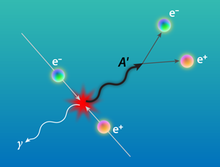In theoretical physics, the dual photon is a hypothetical elementary particle that is a dual of the photon under electric–magnetic duality which is predicted by some theoretical models[3][4][5] and some results of M-theory in eleven dimensions.[1][2]
It has been shown that including magnetic monopole in Maxwell's equations introduces a singularity. The only way to avoid the singularity is including a second four-vector potential, called dual photon, in addition to the usual four-vector potential, photon.[6] Additionally, it was found that the standard Lagrangian of electromagnetism is not dual symmetric that causes dual-asymmetric problems of the energy–momentum, spin and orbital angular-momentum tensors. To resolve this issue, a dual-symmetric Lagrangian of electromagnetism has been proposed,[3] which has a self-consistent separation of the spin and orbital degrees of freedom. The Poincaré symmetries imply that the dual electromagnetism naturally makes self-consistent conservation laws.[3]
Dual electromagnetism
The free electromagnetic field is described by a covariant antisymmetric tensor of rank 2 by
where is the electromagnetic potential.
The dual electromagnetic field is defined as
where denotes the Hodge dual, and
is the Levi-Civita tensor
For both the electromagnetic field and its dual field, we have
Then, for a given gauge field , the dual configuration
is defined as [2]
where the field potential of the dual photon, and non-locally linked to the original field potential
.
p-form electrodynamics
A p-form generalization of Maxwell's theory of electromagnetism is described by a gauge invariant 2-form defined as
.
which satisfies the equation of motion
where is the Hodge star operator.
This implies the following action in the spacetime manifold :[7][8]
where is the dual of the gauge invariant 2-form
for the electromagnetic field.
Dark photon

The dark photon is a spin-1 boson associated with a U(1) gauge field, which could be massless[10] and behaves like electromagnetism. But, it could be unstable and massive, quickly decays into electron-positron pairs, and interact with electrons.
The dark photon was first suggested in 2008 by Lotty Ackerman, Matthew R. Buckley, Sean M. Carroll, and Marc Kamionkowski to explain the 'g–2 anomaly' in experiment E821 at Brookhaven National Laboratory,.[11] Nevertheless, it was ruled out in some experiments such as the PHENIX detector at the Relativistic Heavy Ion Collider at Brookhaven.[12]
In 2015, the Hungarian Academy of Sciences's Institute for Nuclear Research in Debrecen, Hungary, suggested the existence of a new, light spin-1 boson, dubbed the X17 particle, 34 times heavier than the electron[13] that decays into a pair of electron and positron with a combined energy of 17 MeV. In 2016, it was proposed that it is an X-boson with a mass of 16.7 MeV that explains the g−2 muon anomaly.[13][14]

| This article uses material from the Wikipedia article Metasyntactic variable, which is released under the Creative Commons Attribution-ShareAlike 3.0 Unported License. |